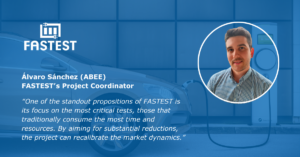
“One of the standout propositions of FASTEST is its focus on the most critical tests, those that traditionally consume the most time and resources. By aiming for substantial reductions, the project can recalibrate the market dynamics.”
Álvaro Sánchez is FASTEST’s project coordinator. He is an Industrial Electronics Engineering for ABEE, a company specialising in battery and energy technologies for automotive and stationary applications. His position in this company, which is the FASTEST’S project leader, has given him a wide vision of the European battery market.
1. Why is this project important for European society?
The FASTEST project holds profound significance for European society in the context of sustainable development and technological advancement. As the world faces environmental challenges, the transition to cleaner energy sources becomes imperative. Batteries, especially those for electric vehicles (EVs) and renewable energy storage, are pivotal in this shift. Europe, with its commitment to green energy and reducing carbon footprints, recognizes the value of efficient battery technologies.
The FASTEST initiative directly addresses the bottlenecks in battery development, which, if alleviated, can propel Europe to the forefront of global battery innovation. By significantly reducing the R&D timeframes and costs, it promises to accelerate the integration of advanced battery technologies into everyday applications. This has wider implications for European society. Faster and more cost-effective battery development can lead to affordable EVs, promoting their adoption among the masses. As more people transition to EVs, cities might witness reduced pollution levels, enhancing public health.
Furthermore, efficient batteries can reinforce the use of renewable energy sources like wind and solar, reducing dependency on fossil fuels. As a result, European nations can make robust strides in their commitments to international environmental agreements, setting a benchmark for other regions to emulate.
2. Which changes can FASTEST bring into the battery market?
The battery market, while blooming, has always faced challenges in terms of prolonged research timelines and substantial development costs. FASTEST seeks to usher in a paradigm shift by introducing a more streamlined and efficient approach to battery R&D. By focusing on the hybridization of testing — combining the virtual with the physical — the project endeavours to optimize the development process.
One of the standout propositions of FASTEST is its focus on the most critical tests, those that traditionally consume the most time and resources. By aiming for substantial reductions, the project can recalibrate the market dynamics. Imagine a scenario where innovations in battery tech, which earlier took years, are now realized in months. This expedited process can lead to quicker market launches, giving companies a competitive edge.
Moreover, the anticipated cost savings, as highlighted by the project’s targets, can have a filtering effect. Reduced R&D expenditures might translate into more competitively priced battery products. This can stimulate demand, especially in sectors like automotive, where battery costs constitute a significant portion of the total vehicle price.
3. What characteristics do you think will make the difference between this new platform and the ones existing nowadays in the market?
The proposition of the FASTEST project lies in its holistic approach to battery testing. Unlike traditional platforms that might lean heavily towards either physical or virtual testing, FASTEST integrates both perfectly. This hybrid testing platform is based on a “smart” Design of Experiment (DoE), a feature that sets it apart. The DoE suggests the optimal distribution between virtual and physical tests, ensuring that while costs and time are minimized, the reliability of results is uncompromised.
Furthermore, the platform’s adaptability is remarkable. It’s equipped to accommodate and integrate a diverse array of models and methods, ensuring that testing is comprehensive. This versatility ensures that the platform remains relevant, even as battery technologies evolve.
In an industry where accuracy and speed are paramount, the FASTEST platform’s ability to provide swift yet reliable results can revolutionize battery testing. Its vision for the future, combining the strengths of the physical and virtual realms, makes it a reference for the future of battery R&D platforms.
